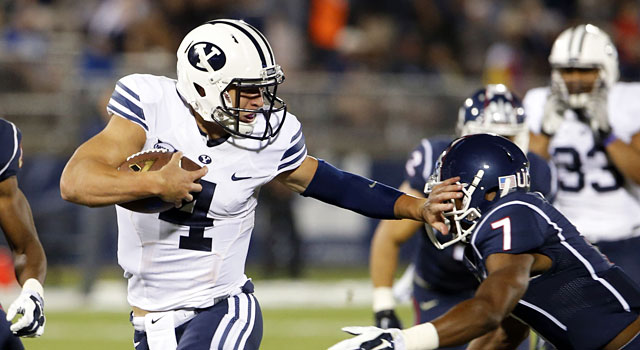
The question I have been asked the most in the early part of this season is how does BYU get to play in one of the big six bowl games?
BYU and its fans are trying to figure out life as an independent in the new order of college football. Obviously, the school feels like it's big-time. It has a national championship (1984) and a following befitting a major program. Unfortunately, recent scheduling snubs from the ACC and SEC send a different message. Those leagues have decided BYU doesn't qualify as a major school in their respective scheduling policies.
Now, they wonder how they will be treated by the selection committee. The answer is simple: like almost everyone else.
The Cougars will have the same opportunity to qualify for one of those six games as any other team that doesn't automatically qualify. The automatic qualifiers are the champions of the five major conferneces, as well as the highest rated champion of the five non-major conferences. BYU and the other independents, Army, Navy and Notre Dame, can't get in that way.
However, there will still be a number of at-large spots left in those six games. The contract bowls (Orange, Rose, Sugar), when necessary, will fill their open spots with teams from their contract conferences, regardless of rankings. However the host bowls (Cotton, Fiesta, Peach) will get the highest rated teams remaining in the selection committee's rankings, regardless of conference. That's the door all four independents can walk through.
The Irish have one other option not available to the other independents. The Orange Bowl matches up a team from the ACC against a opponent from the Big Ten, the SEC or Notre Dame.
Let's look at this year as an example...
The Rose and Sugar Bowls are the semifinal bowls, so they will get the top four teams in the selection committee rankings. Using my projection, we have Alabama, Florida State, Oklahoma and Oregon in those games. Those are all projected conference champions, which means that the Big Ten champion (projected to be Michigan State) still has to be placed somewhere, as does the highest rated non-major champion (Cincinnati).
The Orange fills its matchup next, choosing an ACC team to replace the Seminoles and then the highest rated team from the Big Ten, SEC or ND (Auburn).
Finally, the committee creates the host bowl matchups. It has to use Michigan State and Cincinnati, but still has four other spots. Those go to the highest rated teams left. That's the option for BYU. Realistically, a top ten ranking should be good enough to merit one of those spots.
Note that the number of opportunities will vary from year to year. The maximum this year is six. That scenario would require the non-major AQ to be in the four-team playoff and for the ACC and either the Big Ten or SEC champions to be in the Orange Bowl, so that's not terribly realistic. Having five open spots is a more realistic scenario.
However, in some years, the number of openings could be as few as one. Two years from now, the semifinals will be played two host bowls (Peach and Fiesta). That means only the Cotton Bowl will be available for at-large teams. One team in that game will likely be the non-major AQ, so there would be only one open spot available to the independents.
So, BYU can get there, but the Cougars will have to really impress the selection committee to make it happen.




















